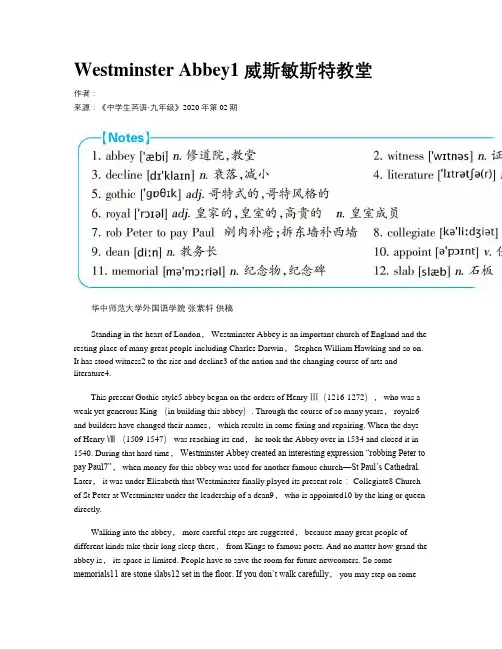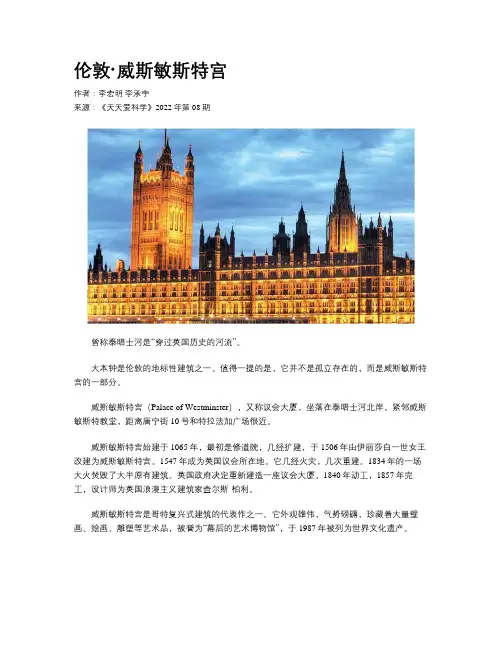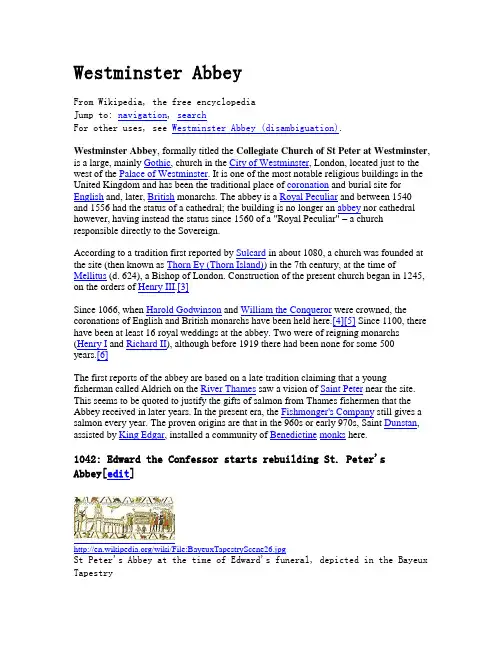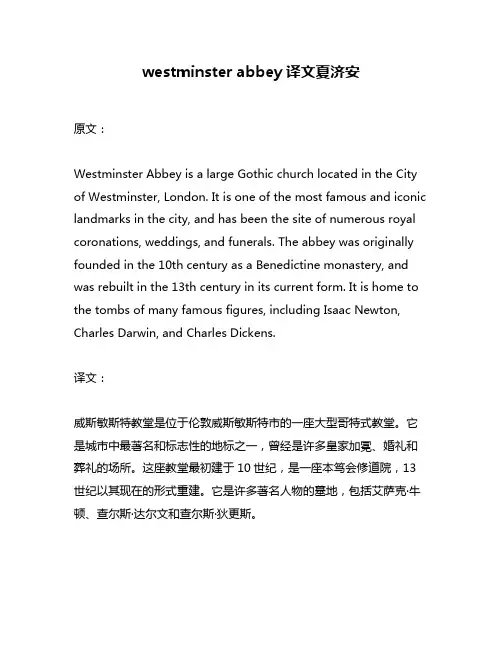WestminsterAbbey威思敏斯特教堂介绍
- 格式:ppt
- 大小:4.35 MB
- 文档页数:18


威斯敏斯特大教堂威斯敏斯特大教堂是位于英国伦敦的一座著名教堂,位于泰晤士河南岸的威斯敏斯特区。
作为英国最重要的宗教建筑之一,威斯敏斯特大教堂不仅是一座古老的宗教场所,也是英国历史和文化的象征。
本文将从建筑风格、历史背景、文化意义等方面介绍威斯敏斯特大教堂。
威斯敏斯特大教堂建于11世纪,是英国最古老的教堂之一。
教堂的建筑风格主要是哥特式,展现了哥特式建筑的特征,如尖拱形门窗、高大的尖塔、雄伟的拱顶等。
教堂的外观巍然壮丽,宏伟的建筑让人仿佛置身于中世纪的宗教世界。
内部空间辽阔,天花板上装饰着华丽的壁画和雕塑,墙上悬挂着神圣的十字架和宗教画作。
教堂内的礼拜堂、教堂会堂等设施完善,为信众提供了举行各种教礼和活动的场所。
威斯敏斯特大教堂对于英国历史具有重要意义。
自建成以来,威斯敏斯特大教堂成为英国皇室的加冕和葬礼地。
国家重要人物、英雄和杰出人物也常选择在这里进行葬礼或纪念仪式。
教堂内的女王长廊是霍利罗德陵墓的所在地,这是英国历史上最重要的王室陵墓之一,其中安葬着伊丽莎白一世、玛丽一世等历代英国君主。
此外,威斯敏斯特大教堂还是英国议会的所在地,重要的国家仪式和重要议事活动都在这里举行。
威斯敏斯特大教堂还被认为是英国文化的象征。
多年来,许多重要的文化活动和艺术表演在教堂内举行,包括音乐会、戏剧演出和传统仪式等。
古老的教堂内流传着丰富的音乐遗产,建有威斯敏斯特修道院合唱团,该合唱团承担着演唱圣诗和宗教音乐的重要角色。
每年圣诞节期间,威斯敏斯特大教堂的音乐会和礼拜仪式吸引了大量的参观者和朝圣者。
此外,教堂的建筑风格和装饰艺术对于后来的建筑和艺术创作产生了深远的影响,成为了英国文化遗产的重要组成部分。
威斯敏斯特大教堂作为一座古老而庄严的宗教建筑,不仅是伦敦的地标之一,也是英国历史和文化的重要象征。
游客可以在这里感受到英国悠久的历史和文化底蕴,欣赏到古老的建筑艺术和宗教艺术之美。
站在教堂内部,仿佛可以与过去的时光产生共鸣,感受到历史的沉淀和文化的传承。

Westminster Abbey1 威斯敏斯特教堂作者:来源:《中学生英语·九年级》2020年第02期华中师范大学外国语学院张紫轩供稿Standing in the heart of London, Westminster Abbey is an important church of England and the resting place of many great people including Charles Darwin, Stephen William Hawking and so on. It has stood witness2 to the rise and decline3 of the nation and the changing course of arts and literature4.This present Gothic-style5 abbey began on the orders of Henry Ⅲ(1216-1272), who was a weak yet generous King (in building this abbey). Through the course of so many years, royals6 and builders have changed their names, which results in some fixing and repairing. When the days of Henry Ⅷ(1509-1547) was reaching its end, he took the Abbey over in 1534 and closed it in 1540. During that hard time,Westminster Abbey created an interesting expression “robbing Peter to pay Paul7”, when money for this abbey was used for another famous church—St Paul’s Cathedral. Later, it was under Elizabeth that Westminster finally played its present role: Collegiate8 Church of St Peter at Westminster under the leadership of a dean9, who is appointed10 by the king or queen directly.Walking into the abbey, more careful steps are suggested, because many great people of different kinds take their long sleep there, from Kings to famous poets. And no matter how grand the abbey is, its space is limited. People have to save the room for future newcomers. So some memorials11 are stone slabs12 set in the floor. If you don’t walk carefully, you may step on somememorials... And it happens, sometimes. It might sound a little terrible for those resting great people, but still, having a tiny space in this church would be the highest honor in England, as it reads on the memorial,“buried among kings”.In addition, as the living symbol of England, Westminster is the place where many important events take place, including royal weddings. If you want to get a quick look at the English history,why not go on a pleasure trip to Westminster Abbey? Then you may find yourself walking through arts, time and the changing history of England.威斯敏斯特大教堂坐落于倫敦市中心,是英国重要的教堂,也是查尔斯·达尔文、斯蒂芬·威廉·霍金等伟人的长眠之地。



伦敦·威斯敏斯特宫作者:李宏明李承宇来源:《天天爱科学》2022年第08期曾称泰晤士河是“穿过英国历史的河流”。
大本钟是伦敦的地标性建筑之一。
值得一提的是,它并不是孤立存在的,而是威斯敏斯特宫的一部分。
威斯敏斯特宫(Palace of Westminster),又称议会大厦,坐落在泰晤士河北岸,紧邻威斯敏斯特教堂,距离唐宁街10号和特拉法加广场很近。
威斯敏斯特宫始建于1065年,最初是修道院,几经扩建,于1506年由伊丽莎白一世女王改建为威斯敏斯特宫。
1547年成为英国议会所在地。
它几经火灾,几次重建。
1834年的一场大火焚毁了大半原有建筑。
英国政府决定重新建造一座议会大厦,1840年动工,1857年完工,设计师为英国浪漫主义建筑家查尔斯·柏利。
威斯敏斯特宫是哥特复兴式建筑的代表作之一。
它外观雄伟,气势磅礴,珍藏着大量壁画、绘画、雕塑等艺术品,被誉为“幕后的艺术博物馆”,于1987年被列为世界文化遗产。
雄伟壮丽的威斯敏斯特宫呈长方形,占地3万平方米,由3排长达300米的平行大楼和7座横行连通的配楼组成。
建筑的顶部林立着针塔般的尖顶,外墙体装饰着镶有花边的尖拱窗、精美的浮雕和飞檐。
楼顶有几座比较突出的高塔。
东北角的方形尖塔是一座96米高的钟楼,塔顶上的那口大钟即为闻名全球的大本钟;西南角的维多利亚塔高102米;中间略矮的那座高塔,是中央大厅塔楼。
威斯敏斯特宫共四层。
第一层有办公室、餐厅和雅座间。
第二层是议会大厅,从南向北依次为皇家画廊(Royal Gallery)、王子厅(Prince's Chamber)、上议院(House ofLords)、贵族厅(Peers'Lobby)、中央大厅(Central Lobby)、议员堂(Members'Lobby)和下议院(House of Commons)。
第三层和第四层是办公室和委员房间。
威斯敏斯特宫有14个大厅和上千个房间,其中以“中央大厅”最为出名。

Westminster AbbeyFrom Wikipedia, the free encyclopediaJump to: navigation, searchFor other uses, see Westminster Abbey (disambiguation).Westminster Abbey, formally titled the Collegiate Church of St Peter at Westminster, is a large, mainly Gothic, church in the City of Westminster, London, located just to the west of the Palace of Westminster. It is one of the most notable religious buildings in the United Kingdom and has been the traditional place of coronation and burial site for English and, later, British monarchs. The abbey is a Royal Peculiar and between 1540 and 1556 had the status of a cathedral; the building is no longer an abbey nor cathedral however, having instead the status since 1560 of a "Royal Peculiar" – a church responsible directly to the Sovereign.According to a tradition first reported by Sulcard in about 1080, a church was founded at the site (then known as Thorn Ey (Thorn Island)) in the 7th century, at the time of Mellitus (d. 624), a Bishop of London. Construction of the present church began in 1245, on the orders of Henry III.[3]Since 1066, when Harold Godwinson and William the Conqueror were crowned, the coronations of English and British monarchs have been held here.[4][5] Since 1100, there have been at least 16 royal weddings at the abbey. Two were of reigning monarchs (Henry I and Richard II), although before 1919 there had been none for some 500 years.[6]The first reports of the abbey are based on a late tradition claiming that a young fisherman called Aldrich on the River Thames saw a vision of Saint Peter near the site. This seems to be quoted to justify the gifts of salmon from Thames fishermen that the Abbey received in later years. In the present era, the Fishmonger's Company still gives a salmon every year. The proven origins are that in the 960s or early 970s, Saint Dunstan, assisted by King Edgar, installed a community of Benedictine monks here.1042: Edward the Confessor starts rebuilding St. Peter'sAbbey[edit]/wiki/File:BayeuxTapestryScene26.jpgSt Peter's Abbey at the time of Edward's funeral, depicted in the Bayeux TapestryBetween 1042 and 1052 King Edward the Confessor began rebuilding St Peter's Abbey to provide himself with a royal burial church. It was the first church in England built in the Norman Romanesque style. It was not completed until around 1090 but was consecrated on 28 December 1065, only a week before Edward's death on 5 January 1066.[7] A week later he was buried in the church, and nine years later his wife Edith was buried alongside him.[8] His successor, Harold II, was probably crowned in the abbey, although the first documented coronation is that of William the Conqueror later the same year.[9]The only extant depiction of Edward's abbey, together with the adjacent Palace of Westminster, is in the Bayeux Tapestry. Some of the lower parts of the monastic dormitory, an extension of the South Transept, survive in the Norman Undercroft of the Great School, including a door said to come from the previous Saxon abbey. Increased endowments supported a community increased from a dozen monks in Dunstan's original foundation, up to a maximum about eighty monks,[10] although there was also a large community of lay brothers who supported the monastery's extensive property and activities.Construction of the present church[edit]Construction of the present church was begun in 1245 by Henry III[3] who selected the site for his burial./wiki/File:London_westminster_1894.jpgA layout plan dated 1894./wiki/File:WestminsterNorth55.jpgThe North Entrance of Westminster Abbey.The abbot and monks, in proximity to the royal Palace of Westminster, the seat of government from the later 12th century, became a powerful force in the centuries after the Norman Conquest. The abbot often was employed on royal service and in due course took his place in the House of Lords as of right. Released from the burdens of spiritual leadership, which passed to the reformed Cluniac movement after the mid-10th century, and occupied with the administration of great landed properties, some of which lay far from Westminster, "the Benedictines achieved a remarkable degree of identification with the secular life of their times, and particularly with upper-class life", Barbara Harvey concludes, to the extent that her depiction of daily life[11] provides a wider view of the concerns of the English gentry in the High and Late Middle Ages.The proximity of the Palace of Westminster did not extend to providing monks or abbots with high royal connections; in social origin the Benedictines of Westminster were as modest as most of the order. The abbot remained Lord of the Manor of Westminster as a town of two to three thousand persons grew around it: as a consumer and employer on a grand scale the monastery helped fuel the town economy, and relations with the town remained unusually cordial, but no enfranchising charter was issued during the Middle Ages.[12] The Abbey built shops and dwellings on the west side, encroaching upon the sanctuary.The abbey became the coronation site of Norman kings. None were buried there until Henry III, intensely devoted to the cult of the Confessor, rebuilt the abbey inAnglo-French Gothic style as a shrine to venerate King Edward the Confessor and as a suitably regal setting for Henry's own tomb, under the highest Gothic nave in England. The Confessor's shrine subsequently played a great part in his canonisation. The work continued between 1245 and 1517 and was largely finished by the architect Henry Yevele in the reign of Richard II. Henry III also commissioned unique Cosmati pavement in front of the High Altar (the pavement has recently undergone a major cleaning and conservation programme and was re-dedicated by the Dean at a service on 21 May 2010).[13]Henry VII added a Perpendicular style chapel dedicated to the Blessed Virgin Mary in 1503 (known as the Henry VII Chapel). Much of the stone came from Caen, in France (Caen stone), the Isle of Portland (Portland stone) and the Loire Valley region of France (tuffeau limestone).1500s and 1600s: dissolution and restoration[edit]In 1535, the abbey's annual income of £2400–2800[citation needed] (£1,280,000 to £1,490,000 as of 2014),[14] during the assessment attendant on the Dissolution of the Monasteries rendered it second in wealth only to Glastonbury Abbey.1540–1550: 10 years as a cathedral[edit]Henry VIII assumed direct royal control in 1539 and granted the abbey the status of a cathedral by charter in 1540, simultaneously issuing letters patent establishing the Diocese of Westminster. By granting the abbey cathedral status Henry VIII gained an excuse to spare it from the destruction or dissolution which he inflicted on most English abbeys during this period.After 1550: difficult times[edit]Westminster diocese was dissolved in 1550, but the abbey was recognised (in 1552, retroactively to 1550) as a second cathedral of the Diocese of London until1556.[15][16][17] The already-old expression "robbing Peter to pay Paul" may have been given a new lease of life when money meant for the abbey, which is dedicated to Saint Peter, was diverted to the treasury of St Paul's Cathedral./wiki/File:Westminster_Abbey_Interior.jpgThe Nave of Westminster Abbey.The Abbey was restored to the Benedictines under the Catholic Mary I of England, but they were again ejected under Elizabeth I in 1559. In 1560, Elizabeth re-established Westminster as a "Royal Peculiar" – a church responsible directly to the Sovereign, rather than to a diocesan bishop – and made it the Collegiate Church of St Peter (that is, a church with an attached chapter of canons, headed by a dean.) The last of Mary's abbots was made the first dean.It suffered damage during the turbulent 1640s, when it was attacked by Puritan iconoclasts, but was again protected by its close ties to the state during the Commonwealth period. Oliver Cromwell was given an elaborate funeral there in 1658, only to be disinterred in January 1661 and posthumously hanged from a gibbet at Tyburn.1722–1745: western towers constructed[edit]The Abbey's two western towers were built between 1722 and 1745 by Nicholas Hawksmoor, constructed from Portland stone to an early example of a Gothic Revival design. Purbeck marble was used for the walls and the floors of Westminster Abbey, even though the various tombstones are made of different types of marble. Further rebuilding and restoration occurred in the 19th century under Sir George Gilbert Scott.A narthex (a portico or entrance hall) for the west front was designed by Sir Edwin Lutyens in the mid-20th century but was not built. Images of the Abbey prior to the construction of the towers are scarce, though the Abbey's official website states that the building was without towers following Yevele's renovation, with just the lower segments beneath the roof level of the Nave completed.Until the 19th century, Westminster was the third seat of learning in England, after Oxford and Cambridge. It was here that the first third of the King James Bible Old Testament and the last half of the New Testament were translated. The New English Bible was also put together here in the 20th century. Westminster suffered minor damage during the Blitz on 15 November 1940.In the 1990s two icons by the Russian icon painter Sergei Fyodorov were hung in the Abbey.[18] On 6 September 1997 the funeral of Diana, Princess of Wales, was held at theAbbey. On 17 September 2010 Pope Benedict XVI became the first pope to set foot in the Abbey.[19]威斯敏斯特圣彼得牧师团教堂(The Collegiate Church of St Peter at Westminster),通称威斯敏斯特修道院(Westminster Abbey,意译为西敏寺),是一座位于伦敦市中心威斯敏斯特市区的大型哥特式建筑风格的教堂,一直是英国君主(从英格兰、不列颠到英联邦时期)安葬或加冕登基的地点。

威斯敏斯特教堂威斯敏斯特大教堂坐落在伦敦泰晤士河北岸,原是一座天主教本笃会隐修院,始建于公元960 年,1045年进行了扩建,1065年建成,1220年至1517年进行了重建。
威斯敏斯特教堂在1540年英王创建圣公会之前,它一直是天主教本笃会(天主教的隐修院修会之一)教堂。
1540年之后,成为圣公会教堂。
威斯敏斯特的本义是西部大教堂的意思。
由于这座教堂在伦敦城的威斯敏斯特大教堂威斯敏斯特大教堂西部,便得此名。
曾有过一座自东撒克逊王塞伯特在公元7世纪建造后便长期矗立的教堂。
威斯敏斯特教堂在伦敦威斯敏斯特教堂的现址上,当时,它本应建在托尼岛。
该岛已经消失,因为泰晤士河道变窄后它与岸地融为一体。
这座教堂的建立似乎是遵循圣伯多禄的指教,据说他曾在首位主教梅里图斯领行的封圣典礼上现身。
从巴耶彩图(彩织广景壁画,生动详细地记录了11世纪诺曼征服者威廉侵占英格兰的过程。
传说为威廉王后玛蒂尔达亲织,画中共有1152人和72幕场景)上看,这座老教堂建有中心塔楼、交成十字横线的两侧耳堂和铅板屋顶。
威斯敏斯特教堂是由“忏悔者”爱德华(1042—1066年在位,因病未能参加威斯敏斯特教堂的封圣典礼。
王后之兄哈罗德二世,成为末代撒克逊族英王。
)扩建,并于1065年被封圣。
亨利三世为了纪念爱德华,发誓建立一座哥特式更加威严的教堂,致使原来的结构所剩无几。
威斯敏斯特教堂从13世纪到16世纪,英格兰的国王们个个为其设计献力,结果把它弄成了各种风格的大杂烩。
如此观察,它与今日的英国王室倒是相配——他们也是出自大量不同的祖源,而长久以来都将威斯敏斯特教堂作为“教区本堂”来举办婚丧仪式和加冕典礼。
威斯敏斯特教堂既非大教区的主教堂,也不是教区里的教堂,而是人们所知的王室专属的教堂,行使管理的教长与其法规都要由王室决定。
虽说平面图上标明入口在堂前左侧,实际上它设在了教堂侧面的北耳堂。
英王“忏悔者”爱德华应教宗利奥九世之请求,将威斯敏斯特教堂敬献于圣伯多禄。

威斯敏斯特大教堂亦称西敏寺,正式名称为“圣彼得联合教堂”,是一座壮丽的哥特式教堂。
它的前身是7世纪时建在泰晤士河一个小岛上的祭祀圣彼得的小教堂。
从创建时起,因为它位于城区以西,寺院就称作威斯敏斯特寺,意为“西寺”,表示是西边的大寺院,以便和位于城东伦敦塔外的一个都会寺院——“东寺”相区别。
威斯敏斯特大教堂是世界上最巍峨壮丽的教堂之一,它的外观恢弘凝重,装潢优美精致,整座建筑金碧辉煌而又静谧肃穆,被认为是英国哥特式建筑中的杰作。
它见证了泰晤士河的千年沧桑,引发人们对千古风流人物的无限感慨,触发着游人的思古幽情。
它不仅是英国最出色的哥特式建筑,还是一座难得的历史博物馆。
Westminster Abbey “美国文学之父”华盛顿·欧文. On one of those sober and rather melancholy days in the latter part of autumn, when the sha dows of morning and evening almost together, and throw a gloom over the decline of the year.I passed several houses in rambling about Westminster Abbey. There was something congenial to the season in the mournful magnificence of the old pile; and. As I passed its threshold. It seemed like stepping back into the regions of antiquity, and losing myself among the shad es of former ages.。

威斯敏斯特大教堂的介绍威斯敏斯特大教堂是世界上最具历史和宗教意义的建筑之一。
位于英国伦敦市中心的白厅西部,它是英国皇室和英国政府的重要场所,也是英国上议院议员和一些重要国家活动的庄严举行地。
这座大教堂的历史可以追溯到公元10世纪。
最早在这个地方建造的是一座小修道院,供奉圣彼得,主要用于王室成员和贵族的宗教仪式。
随着时间的推移,修道院逐渐扩建,成为今天如此壮丽的威斯敏斯特大教堂。
威斯敏斯特大教堂的建筑风格融合了罗曼式、哥特式和英国特有的弗吉尼亚风格,展示了维多利亚时代的建筑精髓。
大教堂的尖塔高耸入云,尖顶和雕塑细节精致华丽,给人一种庄严而又神圣的感觉。
通过参观威斯敏斯特大教堂,我们可以深入了解英国的历史和文化。
在这里,保存着众多英国历代君主的陵墓,包括伊丽莎白一世、英国国教创始人亨利八世和伊丽莎白二世等重要人物。
这些陵墓及其雕刻艺术代表了不同时期的艺术风格,让人们感受到英国历史的厚重和丰富。
此外,威斯敏斯特大教堂还是英国皇室的重要礼堂。
许多皇家婚礼、加冕仪式和国葬都在这里举行。
其中最著名的莫过于2011年威廉王子和凯特王妃的婚礼,整个世界都在电视前见证了这一历史时刻。
作为一座庄严肃穆的教堂,威斯敏斯特大教堂也是信仰和宗教活动的重要场所。
许多人会来这里祈祷、瞻仰圣徒遗物以及参与礼拜仪式。
无论信仰背景如何,大教堂都敞开大门,欢迎全世界的人们前来参观和亲身体验它的神圣与庄严。
总之,威斯敏斯特大教堂是一座历史伟大、建筑精美、文化宝库的代表。
它不仅承载着英国的历史荣光,也让来访者感受到宗教和人类文明的伟大魅力。
无论您是历史爱好者、建筑迷还是宗教信仰者,威斯敏斯特大教堂都将为您带来难忘的体验和深刻的思考。
欢迎您来到这个古老而又神圣的圣地,一同领略它的壮丽和魅力。

westminster abbey译文夏济安
原文:
Westminster Abbey is a large Gothic church located in the City of Westminster, London. It is one of the most famous and iconic landmarks in the city, and has been the site of numerous royal coronations, weddings, and funerals. The abbey was originally founded in the 10th century as a Benedictine monastery, and was rebuilt in the 13th century in its current form. It is home to the tombs of many famous figures, including Isaac Newton, Charles Darwin, and Charles Dickens.
译文:
威斯敏斯特教堂是位于伦敦威斯敏斯特市的一座大型哥特式教堂。
它是城市中最著名和标志性的地标之一,曾经是许多皇家加冕、婚礼和葬礼的场所。
这座教堂最初建于10世纪,是一座本笃会修道院,13世纪以其现在的形式重建。
它是许多著名人物的墓地,包括艾萨克·牛顿、查尔斯·达尔文和查尔斯·狄更斯。
英国历史建筑的悠久历史英国历史建筑丰富多样,凝聚着悠久的历史和丰厚的文化底蕴。
这些建筑物见证了英国国家的发展和演变,重要地标和世界文化遗产。
本文将介绍几个代表性的英国历史建筑,展示其独特之处以及与英国历史和文化的紧密联系。
1. 伦敦塔桥(Tower Bridge)伦敦塔桥是伦敦最知名的地标之一,也是世界上最出名的桥梁之一。
建于19世纪末,它是一座维多利亚风格的悬索桥,位于泰晤士河上。
伦敦塔桥不仅在于其壮观的外观和独特的结构,更在于其历史地位。
作为泰晤士河上的交通要道,它见证了伦敦城市发展的变迁,象征着英国的繁荣与力量。
2. 温莎城堡(Windsor Castle)温莎城堡是英国最大的仍在使用中的皇家宫殿,位于英格兰伯克郡的温莎小镇。
这座城堡建于11世纪,是英国王室的主要居所之一。
温莎城堡具有防御性和居住性的双重功能,其建筑风格融合了中世纪和哥特式元素。
城堡内部陈设豪华,多次进行翻修,展示了不同时期的建筑风格和艺术品收藏,向人们展示了英国王室的历史和权威。
3. 巴斯古罗马浴场(Roman Baths, Bath)巴斯古罗马浴场位于英格兰西南部巴斯市,是一座古罗马时期的温泉浴场遗址。
这个建筑群有2000年的历史,体现了古代罗马人的兴趣和技术。
游客可以在这里领略到古代浴场的壮丽景象,参观博物馆了解古罗马文化,并亲身体验巴斯温泉的疗效。
巴斯古罗马浴场是英国文化遗产中的瑰宝,也是世界文化遗产的代表之一。
4. 威斯敏斯特教堂(Westminster Abbey)威斯敏斯特教堂是英国最重要的教堂之一,位于伦敦威斯敏斯特区。
这座教堂建于11世纪,是英国皇室加冕和葬礼的地点。
威斯敏斯特教堂的建筑风格多样,包括哥特式和文艺复兴式等元素,内部装饰豪华,墓地保存了众多英国历史名人的遗体。
它是英国王室与英国国家象征的重要场所,也是世界文化遗产的代表之一。
5. 斯通黑格(Stonehenge)斯通黑格位于英格兰南部威尔特郡的撒尔泰恩平原上,是世界上最著名的史前遗址之一。
威斯敏斯特教堂介绍
威斯敏斯特教堂(WestminsterChurch),位于英国伦敦的威
斯敏斯特宫(WestminsterPalace)内,是英国最著名的大教堂,也是世界上最大的教堂。
它以其雄伟的建筑、巨大的祭坛和繁复
的装饰闻名于世。
威斯敏斯特教堂是一座哥特式建筑,以其穹顶闻名,建于
15世纪末,1637年启用。
教堂高117.7米(444英尺),长
327.9米(1489英尺),宽206.5米(1056英尺)。
威斯敏斯特教堂的外观是哥特式建筑风格,但内部却是哥特式风格。
它是一座
具有多种功能的建筑。
它不仅是一座教堂,同时也是一个艺术博
物馆和历史博物馆。
它是英国国教和英国王室举行重大仪式的场所,也是欧洲最
大的教堂之一。
整个教堂由大理石砌成,白色大理石板上镶嵌着
彩色玻璃和彩色瓷砖。
整座教堂内部充满了各种中世纪的艺术品
和装饰品,如壁画、雕塑和挂毯等。
这座教堂也被称为“英国文
艺复兴时期最大最漂亮的建筑物”。
—— 1 —1 —。
威斯敏斯特教堂平面分析
西敏寺(WestminsterAbbey),又名威斯敏斯特修道院,坐落在伦敦泰晤士河北岸,毗邻国会大厦,是一座哥特式风格的英国皇家天主大教堂,宏伟壮观,是英国的圣地,在英国众多的教堂中地位显赫。
它既是英国国教的礼拜堂,又是历代国王加冕及王室成员举行婚礼的地方,还是一个国葬陵墓。
这里安葬有诸如牛顿、达尔文和丘吉尔等著名的科学家、文学家和政治人物,安葬在这里代表了至高无上的荣誉,也彰显了英国人民对于才能的尊敬。
整个教堂的建筑雕刻和彩色玻璃都相当精致迷人,但教堂内部不允许拍照。
可以领取导游讲解器,跟着解说的顺序参观,便可很详细了解到每个区域的历史和用意。
威斯敏斯特教堂简介:威斯敏斯特教堂通称威斯敏斯特修道院,是组成伦敦市中心的两个市级区之一。
教堂在英国享有至高无上的地位,而威斯敏斯特教堂被称为“荣誉的塔尖”。
1987年,威斯敏斯特教堂被列入世界文化遗产。
1 概述威斯敏斯特教堂威斯敏斯特教堂通称威斯敏斯特修道院(Westminster Abbey,意译为“西敏寺”),本义是西部修道院的意思,因为这座教堂所在的位置在当时伦敦的西部。
后来,此地也因教堂而命名为威斯敏斯特市,现在是组成威斯敏斯特教堂威斯敏斯特教堂威斯敏斯特教堂是为纪念二战中牺牲于不列颠空战中的空位于修道院的地下礼拜堂中,主要展出历代国王和贵族去世后供凭吊用的雕像。
其中最古老的一座是1377年的爱德华三世雕像。
4.8 圣徒雕塑在教堂西门廊上有十幅浮雕人像,是20世纪的10位基督教圣徒,其中包括在奥斯威辛集中营中代人赴难的圣科尔伯,美国黑人民权运动领袖马丁·路德·金等。
5 旅游指南5.1 交通指南邻近的伦敦地铁站:圣詹姆斯公园站(St James's Park)、威斯敏斯特站(Westminster)5.2 开放时间周一至周五09:30——15:30,周末关闭5.3 门票价格15磅(提示:门票价格与开放时间变动较快,仅供参考,以景区最新公布的信息为准)6 历史文化6.1 建筑风格总体来看,这是一座典型的哥特式建筑,廊柱高大凝重,雕刻精致优美,彩色玻璃华美绚丽,高耸的尖顶、钟楼显得巍峨挺拔,被认为是英国哥特式建筑中的杰作。
但经过13-16世纪历代国王的不断改建、扩建,实际上已经成了各种建筑风格的大杂烩。
在19世纪的最后一次修整中,设计师大胆拆除了一些非哥特式的构件和艺术作品,使得教堂部分恢复了哥特风格的原貌。
6.2 文化在这儿长眠着许多著名的诗人和小说家。
英国14世纪的“诗圣”乔叟、诗人丁尼生和布朗宁、小说家哈代、德国著名的作曲家亨德尔、19世纪最杰出的现实主义作家狄更斯、1907年诺贝尔文学奖获得者吉卜林都葬在这里。